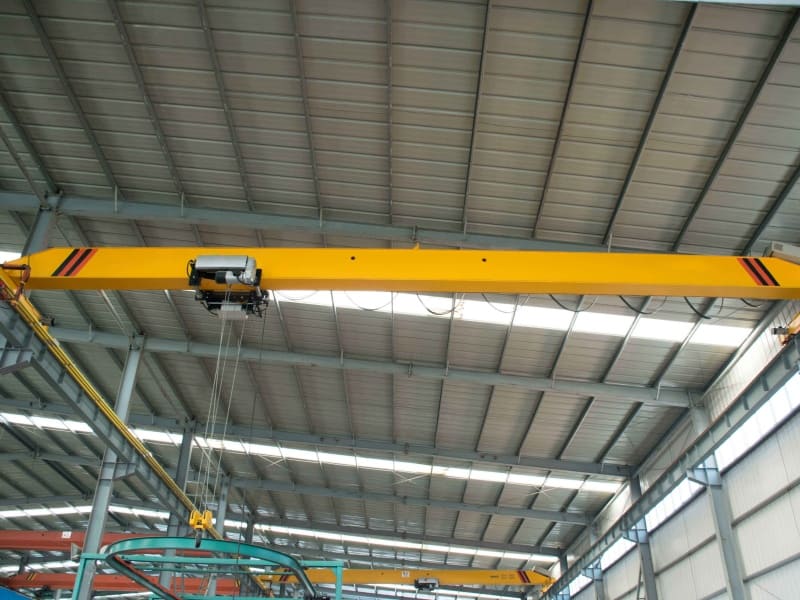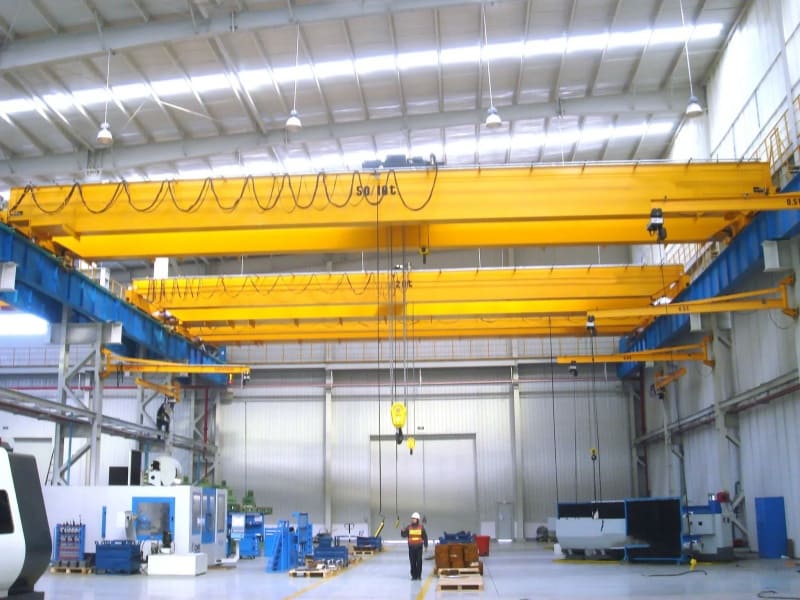Overhead crane (bridge crane, EOT crane) is composed of bridge, travelling mechanisms, trolley, electric equipment. The bridge frame adopts box welded structure, the crane travelling mechanism adopts separate drive withe motor and speed reducer. It is characterized by more reasonable structure and higher strength steel as a whole.
♦Each overhead crane must have a clearly visible plate indicating its rated lifting capacity.
♦During operation, no personnel are allowed on the bridge crane structure, and the crane hook must not be used to transport people.
♦Operating an EOT crane without a valid license or under the influence of alcohol is strictly prohibited.
♦When operating any overhead crane, the operator must stay fully focused—no talking, smoking, or unrelated activities are allowed.
♦Keep the bridge crane clean; do not store tools, equipment, flammable items, explosives, or hazardous materials on it.
♦Never operate the EOT crane beyond its rated load capacity.
♦Do not lift loads in the following cases: unsecured binding, mechanical overload, unclear signals, diagonal pulling, items buried or frozen to the ground, loads with people on them, flammable or explosive items without safety measures, overfilled liquid containers, wire ropes not meeting safety standards, or faulty lifting mechanisms.
♦When the overhead crane travels along a clear path, the bottom of the hook or load must be at least 2 meters above the ground. When passing over obstacles, it must be at least 0.5 meters higher than the obstacle.
♦For loads less than 50% of the bridge crane’s rated capacity, two mechanisms can operate simultaneously; for loads over 50%, only one mechanism may operate at a time.
♦On an EOT crane with main and auxiliary hooks, do not raise or lower both hooks at the same time (except under special conditions).
♦Do not weld, hammer, or work underneath a suspended load unless it is securely supported.
♦Inspections or maintenance on overhead cranes should only be done after power is cut and a warning tag is placed on the switch. If work must be done with power on, proper safety measures and supervision are required.
♦Never throw objects from the bridge crane to the ground.
♦Regularly check the EOT crane’s limit switches and interlock devices to ensure proper function.
♦Do not use the limit switch as a normal stopping method for the overhead crane.
♦If the hoist brake is faulty, lifting operations must not be carried out.
♦The suspended load of a bridge crane must never pass over people or equipment.
♦When welding on any part of the EOT crane, use a dedicated ground wire—never use the crane body as the ground.
♦When the hook is in its lowest position, at least two turns of wire rope must remain on the drum.
♦Overhead cranes must not collide with each other, and one crane must never be used to push another.
♦When lifting heavy loads, molten metal, explosives, or dangerous goods, first lift the load slowly to 100–200mm above the ground to test the brake’s reliability.
♦Lighting equipment for inspection or repair on bridge cranes must operate at a voltage of 36V or below.
♦All electrical equipment casings on EOT cranes must be grounded. If the trolley rail is not welded to the main beam, weld a grounding wire. The grounding resistance between any point on the crane and the power neutral point must be less than 4Ω.
♦Conduct regular safety inspections and carry out preventive maintenance on all overhead crane equipment.
Safety Devices for Bridge Cranes
To ensure the safe operation of hook bridge cranes and prevent accidents, multiple protective devices are installed:
Load Limiter: Prevents overloading, a major cause of crane accidents.
Limit Switches: Includes upper and lower travel limits for hoisting mechanisms, and travel limits for trolley and bridge movement.
Buffers: Absorb kinetic energy during trolley movement to reduce impact.
Anti-Collision Devices: Prevent collisions between multiple cranes operating on the same track.
Anti-Skew Devices: Reduce skewing caused by manufacturing or installation deviations, preventing structural damage.
Other Safety Devices: Rain covers for electrical equipment, anti-tipping hooks on single-girder bridge cranes, and other measures to ensure operational safety.









